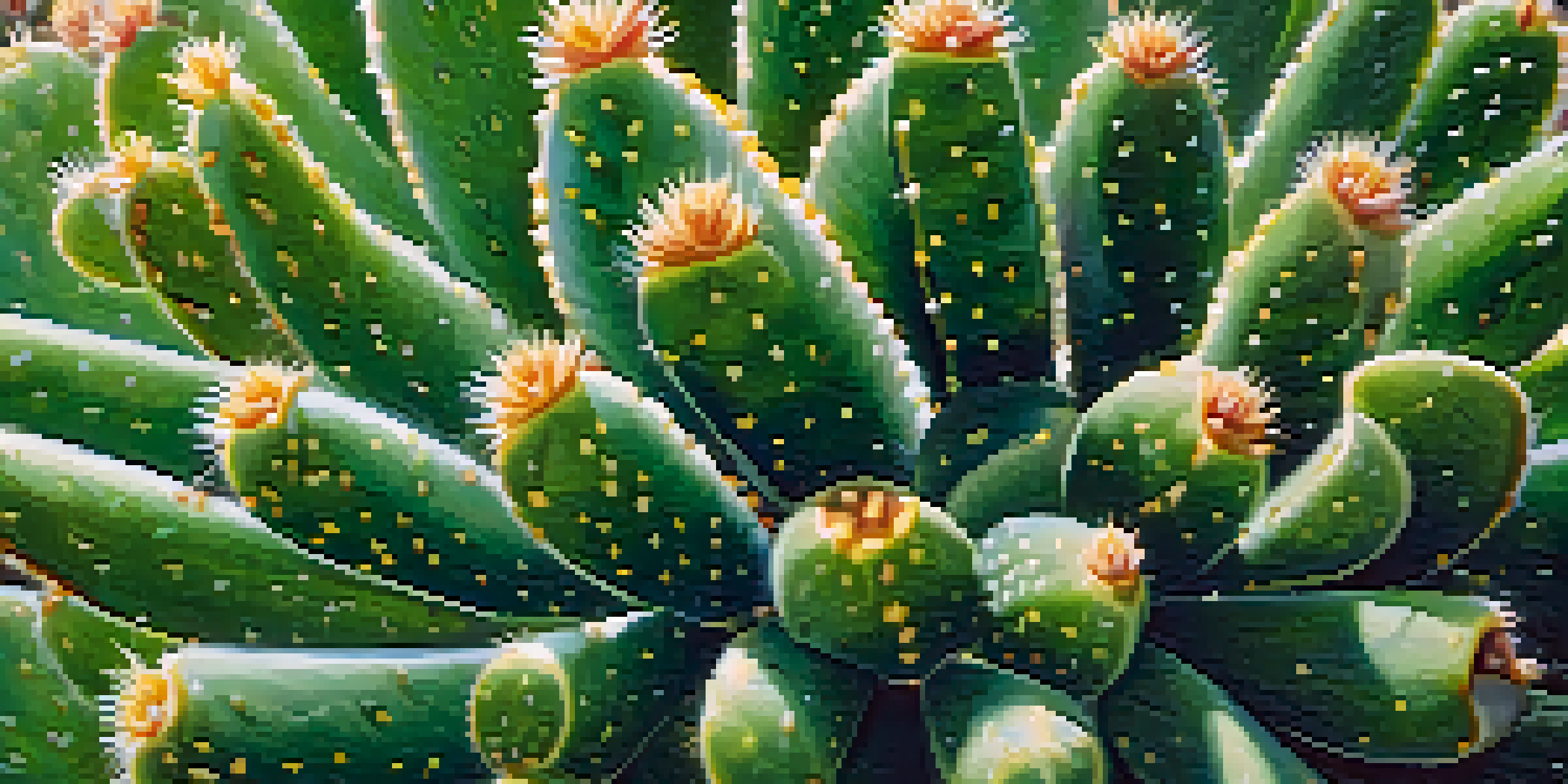Understanding Peyote: A Guide for Addiction Recovery Seekers

What is Peyote? An Overview of the Plant and Its Uses
Peyote is a small, spineless cactus known scientifically as Lophophora williamsii. It has a long history of use among Indigenous peoples in Mexico and the United States for spiritual and healing purposes. Traditionally, peyote is consumed during ceremonies to induce altered states of consciousness, which many believe can foster personal insights and healing.
The use of peyote is a pathway to self-exploration and healing, transcending the physical to connect with the spiritual.
The primary psychoactive component in peyote is mescaline, a compound that affects the brain's neurotransmitters, leading to changes in perception, mood, and cognition. This unique experience has intrigued researchers and those seeking alternative methods for healing, especially in the realm of addiction recovery. Understanding peyote's effects and the context of its use is essential for anyone considering it as a therapeutic option.
As interest in holistic and alternative medicines grows, peyote is gaining attention for its potential benefits. Yet, it’s crucial to approach this powerful plant with respect and a clear understanding of its cultural significance and legal status.
The Historical and Cultural Context of Peyote Use
Peyote has been used for thousands of years, particularly by Native American communities. Its significance goes beyond mere recreation; it is a sacred plant that plays a vital role in rituals and spiritual practices. The Native American Church, for instance, incorporates peyote into its ceremonies, emphasizing its importance as a tool for spiritual enlightenment and healing.

Understanding this cultural background is essential for anyone considering peyote for addiction recovery. It’s not just about the substance itself, but also the traditions and ceremonies that surround its use. Engaging with peyote in a respectful and informed manner aligns with the values of many Indigenous communities who see it as a gift from the Earth.
Peyote's Cultural Significance
Peyote is a sacred plant used in spiritual rituals by Indigenous communities, emphasizing the importance of understanding its cultural context.
Additionally, the legal status of peyote can vary significantly depending on the region and the context in which it is used. Being aware of these nuances can help individuals navigate their journey more thoughtfully and ethically.
The Connection Between Peyote and Addiction Recovery
Many people struggling with addiction seek out alternative therapies, and peyote is increasingly being recognized for its potential benefits. Some studies suggest that the psychoactive effects of mescaline may help individuals confront their addiction by providing profound insights and emotional release. This can be particularly helpful for those grappling with the underlying issues that contribute to their substance use.
Psychedelics can open doors to profound insights, but they must be approached with respect and understanding.
Moreover, the experience of consuming peyote can foster a sense of connection and community, particularly when partaken in a ceremonial context. This social aspect can be vital for individuals in recovery, as building a support network is often a key factor in overcoming addiction. It underscores the importance of holistic approaches that address both the mind and the spirit.
However, it's important to remember that peyote is not a cure-all. It should be viewed as a complementary practice to traditional treatment methods rather than a standalone solution. Open discussions with healthcare providers are crucial for safely integrating peyote into a recovery plan.
The Science Behind Peyote: What Research Tells Us
Scientific interest in peyote and its active ingredient, mescaline, has been growing, particularly regarding their effects on mental health. Research indicates that psychedelics can lead to lasting changes in perspective and behavior, which are essential in recovery contexts. Some clinical trials have shown promising results in reducing anxiety, depression, and even addiction symptoms.
The mechanisms through which peyote may facilitate recovery are still being studied, but many researchers believe that psychedelics can help 'reset' the brain. This reset can allow individuals to break free from negative thought patterns and behaviors that fuel addiction. By promoting neuroplasticity, peyote might help create new pathways for healthier coping strategies.
Potential in Addiction Recovery
Research suggests that peyote, particularly its active ingredient mescaline, may offer profound insights that help individuals confront and heal from addiction.
While the findings are encouraging, more extensive research is needed to fully understand the implications of peyote use in addiction recovery. It’s essential to approach this area with caution, ensuring that any use is backed by scientific evidence and conducted in a safe environment.
Potential Risks and Considerations When Using Peyote
Despite its potential benefits, using peyote is not without risks. The psychoactive effects can vary greatly from person to person, leading to unpredictable experiences. Some individuals may encounter challenging emotions or flashbacks that could exacerbate their condition rather than help it, particularly if they have a history of mental health issues.
Additionally, the legality of peyote can complicate matters. In many areas, its use is restricted or illegal outside of sanctioned religious ceremonies. This legal gray area can lead to ethical dilemmas and potential legal consequences for individuals seeking its use for therapeutic purposes.
Therefore, it’s crucial for anyone considering peyote to consult with a healthcare professional. Establishing a safety plan and understanding the potential risks can help mitigate adverse effects and promote a more positive and healing experience.
Integrating Peyote into a Holistic Recovery Plan
For those interested in incorporating peyote into their recovery journey, it’s essential to do so mindfully and holistically. This means viewing peyote as just one component of a broader recovery strategy that includes therapy, support groups, and lifestyle changes. A well-rounded approach can enhance the benefits of peyote while addressing various aspects of addiction.
Engaging in complementary practices like yoga, meditation, or nature therapy can also enrich the recovery experience. These practices can help ground individuals, offering them tools to cope with the emotional and psychological challenges that often accompany addiction recovery. When combined with peyote, they may create a more profound healing journey.
Risks and Ethical Considerations
Using peyote comes with risks, including unpredictable psychoactive effects and legal complexities, necessitating consultation with healthcare professionals.
Creating a supportive environment where individuals feel safe to explore their experiences with peyote is vital. This could involve joining groups or communities where others share similar experiences, fostering a sense of belonging and understanding.
Finding Support and Resources for Peyote Use in Recovery
As the interest in alternative therapies like peyote grows, so too do the resources available for those seeking support. Numerous organizations and online communities offer information, guidance, and shared experiences regarding peyote use in recovery contexts. Connecting with these resources can help individuals make informed decisions and feel less isolated in their journeys.
Additionally, seeking out trained facilitators or practitioners experienced in guiding peyote ceremonies can provide a safer and more structured environment for exploration. These individuals can help navigate the emotional and spiritual landscape that often accompanies peyote use, ensuring that participants feel supported throughout the process.

Ultimately, finding the right support systems is crucial for anyone considering peyote in their recovery journey. Whether through community, professional guidance, or educational resources, building a solid support network can make all the difference in achieving lasting recovery.